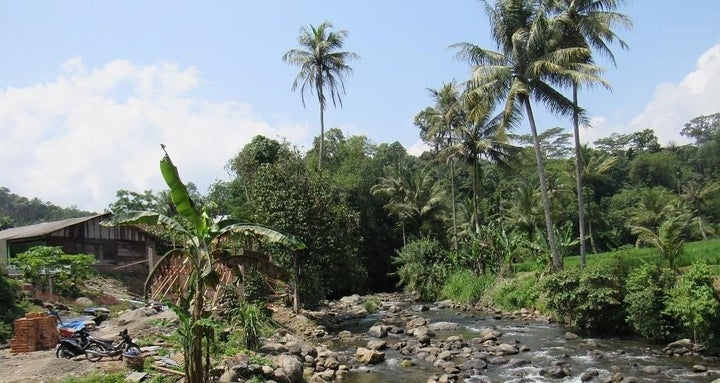The earliest recorded history of Rumah Kinangkung, a small village in north Sumatra, Indonesia tells of the Dutch invaders who came to Indonesia in the early 1600s. The forests surrounding the village were used by the local resistance to conduct guerrilla warfare against the Dutch occupation force. The natives lost that struggle and Indonesia became the Dutch East Indies.

The Dutch Occupation of Indonesia ended only when the Japanese invaded Indonesia in 1942. Throughout this whole time, the village of Rumah Kinangkung and its residents survived off what protection and food the surrounding jungles provided. The close ties between the forest dwellers and their surroundings remain today but things have changed.
Protection For Forests on Paper
As recently as 2015, Rumah Kinangkung was portrayed as a model for sustainable development. The fact that clean potable water was available from area streams which also provided the micro-hydro electricity supply was an achievement few other villages in Indonesia could boast of. The greater area around the village is the district of Sibolangit, which is considered to be such a safe haven for wildlife that rescued animals and endangered birds have been released into its wilderness.
The area is considered a protected forest or “hutan lindung” in Indonesian language. According to Indonesian regulations and definitions of a protected forest, it is an area which is supposed to have strong conservation measures besides providing for its local communities. Protected forests are therefore defined as:
"…. a forest containing a basic function as the protection of life support systems to regulate the water system, prevent floods, control erosion, prevent sea water intrusion and maintaining soil fertility."
The protected forests in Indonesia are not what we might envision in the West with our national parks. The ones I’ve seen personally including Gunung Palung National Park and Sebangau National Park, look more like degraded farm areas than pristine forests. The problem here is that human settlements were established long before the government decided to classify these forests as protected and these people still live within these protected forests! This Google map shows where some of these protected forests are in Indonesia.
Forests as A Free Supermarket
The special relationship between forest dwellers and their ability to protect their forests as a means of survival is a well documented one. Whether it’s the taking of a wild animal for food or the harvest of medicinal plants to cure ailments or the cutting of a tree to build shelter, their ways have been celebrated as a selfless way to protect forests for all humanity.
The threat to biodiversity starts when these free supplies of forest products are harvested for commercial sale. The forests maybe able to supply one village’s needs but it cannot supply the wants of people far away.
The “empty forests” as reported in this article on Mongabay is happening in real time in Rumah Kinangkung. There was a time when village hunters could easily catch pangolins or the Helmeted hornbill to supply the market demand. That’s no longer the case. Village hunters are reporting that these species are becoming extremely rare in the area. Likewise for songbirds like bulbuls which have both a local and export market. A recent study identified thirteen bird species in Indonesia as being at risk of extinction.
Martin Williams, a birder and photographer based in Hong Kong speaks sarcastically of “places in Java densely packed with these birds” which actually shows a bird market. Quoting Martin Williams from a chat we had:
I've seen trapping and bird markets in other places, including China. But Java seems far more intensive; there's astonishing lack of even "common" birds in many places like farmland, typical woods - which I'd otherwise expect to be alive with sounds and sights of birds.
When the empty forests article was published in Mongabay three years ago, conservation efforts globally were already said to be failing. Quoting from the article above:
“There is a need to acknowledge the unpalatable but undeniable fact that current tropical conservation efforts are failing.”
A more recent article identifies the “lack of local buy-in or support” and “funding” as one of the five major reasons why conservation projects fail.
Even when massive funding is available the present conservation methods are still failing as in the case of Congo where a reported $500 million dollar conservation fund has yielded little results. These failures have all been attributed to the top down methods that do not address local situations.
Including Local Communities as The Way Forward for Conservation
In the case of Rumah Kinangkung and its 70 households, Indonesian NGO, Indonesian Species Conservation Program ( ISCP ) is working a project from the bottom up. Having studied the area for the past three years, ISCP is now engaging local communities in conservation. The challenge will be to find alternative livelihoods for these people. A live pangolin for example, can fetch $30 per kilo while the casque of the Helmeted hornbill can bring as much as $600 each. These are good payouts for people whose income from forest products average $150 monthly.
Convincing all the hunters from the village to stop hunting and work in farming will not be easy as the villagers see it as a customary right and tradition to take from the forests. ISCP’s researched showed that most of the villagers actively hunt for food and income. Others that claimed that they did not hunt, admitted that they do kill any wildlife that threatens their crops.
Rudianto Sembiring who heads ISCP is worried about the status of wildlife in the area.
It’s not only the birds that have disappeared from our forests. Pangolins are becoming very rare.
Potential wildlife in the forest area of Sibolangit is big, especially in the vicinity of protected forest village areas in Rumah Kinangkung, Pagaraji and Buluhawar. These areas border with Bukit Barisan park as well as the Leuser Ecosystem area where many of us encounter animal wildlife such as silver leaf mongkey, macaca, gibbon , siamang, sun bears , orangutans and pangolin.
We have to raise the profile of forest areas in Sibolangit to the same level as the Leuser in Aceh, Langkat, Batang Toru, Batang Gadis and other high conservation areas in North Sumatra.
A farmers co-op has been created with a few families to grow high demand crops like palm sugar and asam gelugur. Both of these require a few years before their fruits can be harvested so in the meantime, fast growing crops like chili peppers and corn will be planted in a permaculture set up to provide food and income.
Will a low budget conservation project succeed where big funds from international conservation groups have failed? I think so. The mistakes made by the big conservation groups in excluding local communities have been noted by ISCP. The biggest concern that the director, Rudianto has, is that he has to learn a new skill for conservation, which will be marketing the produce from the farmers group to ensure their income from farming will be enough to reduce their dependence on the forests.
In his most recent trip into the forests around Rumah Kinangkung village, hornbills were seen. It’s a good sign that it’s not too late to introduce conservation to the area by providing the forest peoples with alternate livelihoods.
